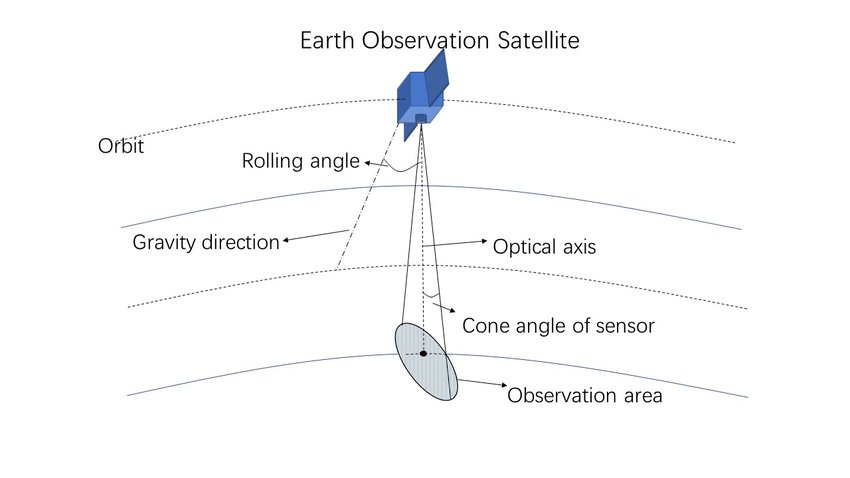pyorbital
 pyorbital copied to clipboard
pyorbital copied to clipboard
How compute satellite look angle?
Hi. I have in input only tle. How calcullate observation area?


Hi, TLE is a good start, but you need more information than this to compute the observation area, in particular the characteristics of the sensor like the resolution and min/max scanning angle along and across track.
Once you have this, you can try to define a scanning geometry like here: https://github.com/pytroll/pyorbital/blob/main/pyorbital/geoloc_instrument_definitions.py and then use something like this to get the positions of your sensor's pixels on the ground: https://github.com/pytroll/pyorbital/blob/main/pyorbital/geoloc_example.py
Good luck!
@mraspaud thx! I try run geoloc_example.py but its raise error
ValueError: operands could not be broadcast together with shapes (3,17901) (1,2)
Yes, the script might not be up to date, but if you have the sensor definition set properly, I'm sure you can adapt the example to your use case :)
but if you have the sensor definition set properly,
could you pls give some hint? which param https://i.ibb.co/0hJFHct/xixa.png
I have no idea what sensor you are working with, so it's going to be difficult for me to give you a hint :sweat_smile:
If you paste your sensor definition in the same format as in https://github.com/pytroll/pyorbital/blob/main/pyorbital/geoloc_instrument_definitions.py and a suitable TLE, I'll try to find some time to take a look at this.
Thx for reply) Ok. I try work with sat SUOMI NPP All works (may be), but way of satellite incorrect


from geoloc_instrument_definitions import avhrr
import numpy as np
from datetime import datetime
from pyorbital.geoloc import ScanGeometry, compute_pixels, get_lonlatalt
from mpl_toolkits.basemap import Basemap
import matplotlib.pyplot as plt
from pyorbital.orbital import Orbital
tle1 = "1 37849U 11061A 22207.46972667 .00000025 00000-0 32513-4 0 9995"
tle2 = "2 37849 98.7330 145.4829 0001172 89.7809 20.2392 14.19535383556723"
t = datetime(2022, 7, 26, 19, 4, 1, 575000)
scanline_nb = 10
scan_points = np.arange(24, 2048, 40)
sgeom = avhrr(scanline_nb,scan_points)
rpy = (0, 0, 0)
s_times = sgeom.times(t)
pixels_pos = compute_pixels((tle1, tle2), sgeom, s_times, rpy)
pos_time = get_lonlatalt(pixels_pos, s_times)
m = Basemap(projection='eck4', llcrnrlat=24, urcrnrlat=70, llcrnrlon=-25, urcrnrlon=120,
lat_ts=58, lat_0=58, lon_0=14, resolution='l')
x, y = m(pos_time[0], pos_time[1])
p1 = m.plot(x, y, marker='+', color='red', markerfacecolor='red', markeredgecolor='red', markersize=1, markevery=1,
zorder=4, linewidth=0.0)
m.fillcontinents(color='0.85', lake_color=None, zorder=3)
m.drawparallels(np.arange(-90., 90., 5.), labels=[1, 0, 1, 0], fontsize=10, dashes=[1, 0],
color=[0.8, 0.8, 0.8], zorder=1)
m.drawmeridians(np.arange(-180., 180., 5.), labels=[0, 1, 0, 1], fontsize=10, dashes=[1, 0],
color=[0.8, 0.8, 0.8], zorder=2)
plt.show(block=True)
I'm not sure I understand. The plot shows north America, but the Basemap definition seems to be over Europe?
counter question - plot shows position of satellite on proper datetime?
yes. Don't forget the time should be given in utc.

Here is the script I used to generate this image:
from pyorbital.geoloc_instrument_definitions import avhrr
import numpy as np
from datetime import datetime
from pyorbital.geoloc import ScanGeometry, compute_pixels, get_lonlatalt
import matplotlib.pyplot as plt
import cartopy.crs as ccrs
import cartopy.feature as cfeature
from pyorbital.orbital import Orbital
def main():
# Noaa 19, july 27 2022
tle1 = "1 33591U 09005A 22208.15634740 .00000133 00000+0 97035-4 0 9993"
tle2 = "2 33591 99.1455 243.1224 0014915 77.9753 282.3088 14.12592326694052"
t = datetime(2022, 7, 27, 14, 10, 0)
scanline_nb = 10
scan_points = np.arange(24, 2048, 40)
sgeom = avhrr(scanline_nb,scan_points)
rpy = (0, 0, 0)
s_times = sgeom.times(t)
pixels_pos = compute_pixels((tle1, tle2), sgeom, s_times, rpy)
pos_time = get_lonlatalt(pixels_pos, s_times)
fig = plt.figure()
proj4_params = dict(proj='eck4',
lat_ts=58, lat_0=58)
crs = ccrs.PlateCarree(14)
ax = fig.add_subplot(1, 1, 1, projection=crs)
ax.set_extent([-25, 120, 24, 90], crs=crs)
ax.add_feature(cfeature.LAND)
ax.add_feature(cfeature.OCEAN)
ax.add_feature(cfeature.COASTLINE)
x, y = (pos_time[0], pos_time[1])
p1 = plt.plot(x, y, marker='+', color='red', markerfacecolor='red', markeredgecolor='red', markersize=1, markevery=1,
zorder=4, linewidth=0.0)
plt.show()
if __name__ == '__main__':
main()
And what another website reports:

Ok, we have satellite trajectory on purpose datetime. Main question - how calc observation area?

The script you have provides observation points, right? So from there you can get pixels for given times of interest.
I guess this lines are swath ?

yes, approximately. You may want to compute some more times in between, a swath is usually more rounded (I'm assuming the satellite goes horizontally in this image)
I added some more scan lines and its look like spline)

But in summary, Width of swath != satellite capture band. Its may be smaller etc... How calc this radius?
A you can see in the previous script, the points compute across track are scan_points = np.arange(24, 2048, 40)
if you want just the edges, set scan_points = np.array([0, 2047])...
Hi again) could you pls explain how compute scangeometry for kanopus v1 ?. It's has 2 sensors

This is unfortunately not enough information to do that. You need to know the scan pattern (sweep, push broom, circular, etc), the scanning angles for each pixel (or at least at the edges if this is what you are interested in), the resolution, etc...
sorry, incorrectly expressed. How calc IFOV ? (for kanopus v1)

yes, that's the question! you need to find a technical description of the instrument that gives you the angle values for the IFOV and FOV